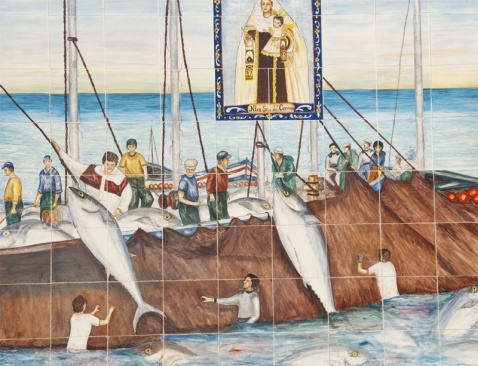
Tiles on a church in Conil showing traditional almadraba tuna fishing. |
|
THE ALMADRABA: CATCHING BLUE-FIN TUNA THE TRADITIONAL WAY
Every year in May, after the first full moon, fishermen from towns on the Cadiz part of the Costa de la Luz, including Barbate, Zahara de los Atunes, Conil de la Frontera, and Tarifa, set up a complicated labyrinth of nets off the Atlantic coast, called the almadraba, to catch blue-fin tuna. This is a major social and gastronomic event, providing essential (if seasonal) work for fishermen, packing factories, restaurants along the coast.
What is the fish?
Known as atun rojo (red tuna, thunnus thynnus) here in Spain, this dark red-coloured fish is highly prized - if you've ever tasted its sweet, dense yet tender flesh, you'll know why. Almadraba tuna is not cheap: around €25/kilo for the basic cuts, rising to nearly €40/kilo for the prized barriga (belly). The Japanese export 80% of it - filleted, frozen and air-freighted within hours - to make sushi and sashimi. In Spain it is eaten raw, as tuna tartare, since its superb flavour and texture means it is best appreciated without cooking.
What is the almadraba?
Invented by the Phoenicians 3000 years ago, the almadraba is an ingenious system - the nets are positioned precisely in the section of the sea (close to the Straits of Gibraltar) where the tuna pass on their way to Mediterranean, as they migrate to warmer water. With fat reserves to keep warm during the winter, and to provide energy for the long journey south, the fish is at its most succulent. The tuna swim through different parts of the nets until they're caught in a central area, encircled by a ring of boats; the net is then lifted and the largest specimens selected by the expert fishermen - each can weigh more than 500kg. This is called the levantá (raising); the net is then lowered back in to the sea - the bajá. The filleting is called el ronqueo, as the noise of the meat being taken off the bones sounds like snoring.
They also have almadrabas when the tuna return from the Mediterranean to the Atlantic, in September and October, but these tuna produce drier, less fatty meat, destined for the canneries; the spring catch is considered of superior quality.
The almadraba, which comes from an Arabic word meaning fight or strike, is a perfect example of sustainable fishing - only the tuna are caught, no other fish, and only the biggest of them are kept; the others are returned to the ocean. There is no waste, and no over-fishing - the fishermen know exactly which specimens they want; there's a strict quota, and it's not in their interests to exceed it.
Where can I see the almadraba?
A few local specialist tour companies offer the chance to witness the Almadraba first-hand in Barbate. Flexibility is needed because fishing is dictated by the weather and tuna shoals, so dates may be confirmed - or changed - last-minute. if you are interested, contact us via the link on the bottom left-hand side of this page.
Where can I eat almadraba tuna?
You can also taste atun de almadraba in restaurants all over Spain, but it's best when fresh from the sea. If you're lucky enough to try almadraba tuna in Andalucia, as well as savouring its extraordinary flavour, try to think about the arduous and complicated journey it has taken to arrive on your plate.
Lovers of tuna come from all over Spain to enjoy the various festivals and routes celebrating the almadraba season. The towns on the Costa de la Luz have their own Rutas del Atun, which list restaurants and tapas bars offering inventive, beautifully-presented atun de almadraba tapas at a set price, for example 4 euros; maps are available to show you where participating restaurants are.
Ruta del Atun - Tuna Route
Typical examples of 'Ruta del Atun (Tuna Routes) in May each year are the Semana Gastronomica del Atún en Barbate, Ruta Gastronómica del Atún de ConilRutal de Atun, Zahara de los Atunes, La Linea, Ruta del Atun Rojo, Tarifa, Ruta de Atun Algeciras. So if you are visiting the region and May dates are limited you will be able to find a Ruta del Atun taking place in May in one of the town. More info>
Historical documentry of the Almadraba